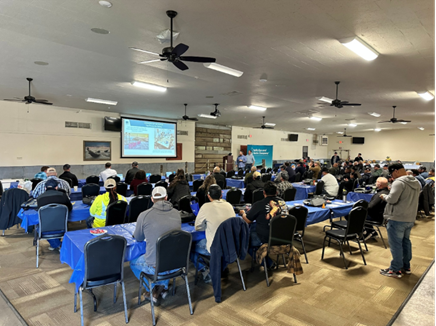Safety Steward Participation Grows 147% Since 2021

Hold the Pull presenting at the Fresno unit meeting.
IBEW 1245’s Peer-to-Peer Safety Committees achieved major growth in 2025, reaching more than 4,000 members across the jurisdiction — the largest engagement since the program began in 2009. The number of Safety Stewards has also grown dramatically, from roughly 150 in 2021 to more than 370 today, reflecting a powerful, member-driven commitment to safety culture.
The four committees — Hold the Pull (HTP), Keep the Clearance (KTC), Regulate the Voltage (RTV), and Control the Pressure (CTP) — delivered safety messages at apprenticeship classes, unit meetings, job sites, yards, and safety summits — often reaching hundreds of members at a single event. They also strengthened partnerships with outside utilities, including NV Energy and municipal partners, helping spread the peer-led safety culture to new regions.
“With over 350 Safety Stewards, the peer groups are making a difference for our members and their families,” said Peer-to-Peer Coordinator and Business Representative Fred Aboud. “Peer-led safety saves lives. Thank you to Business Manager Bob Dean for the continuous support of these programs.”
Peer Group Highlights — 2025

RTV attended PG&E’s Monterey Substation Safety Summit to introduce the program and engage with members throughout the day.
Hold the Pull (HTP) — Electric Line Safety
Chair: Brady Brunson • Recorder: Mike Van Egmond
HTP introduced a new approach this year by meeting crews directly on job sites, prompting more open conversations about hazards, mental health, and real-world challenges. They delivered dozens of pitches — from apprentice classes in Livermore to yard visits in Oakland and Richmond, large unit meetings in Fresno and San Francisco, and a joint visit to Wheeler & Wells Rural Electric in Nevada,
Control the Pressure (CTP) — Gas & Water Safety
Co-Chairs: Kevin Foster & Mike Gauchi & Lamont Presley • Recorder: Nilda Holguin
CTP elevated the “if you see something, say something” message through powerful peer testimony from members who survived workplace assaults and trauma, turning lived experience into life-saving lessons. The committee had a standout year, with major presence at Gas System Operations & Maintenance (GSOM), Gas Pipeline Operations & Maintenance (GPOM), and GC Traffic & Spoils Safety Summits, as well as NV Energy presentations on joint trench hazards. They also led Mod 0 sessions for new hires on complacency, hostile customer safety, and speaking up.

CTP joined more than 250 members at the Sacramento GC Gas Safety Summit, sharing the “speak up” message and signing up new Safety Stewards.
Keep the Clearance (KTC) — Vegetation Management Safety
Chair: Jose Paredes • Recorder: Russ Gordon
KTC continued to expand its outreach in 2025, bringing its safety message to vegetation management crews across multiple regions. The committee delivered presentations at safety summits, unit meetings, and job sites, strengthening awareness around the unique hazards of remote terrain, steep ground, and high-fire areas. Their steady presence kept safety front and center in one of the most high-risk classifications, reinforcing the importance of vigilance and peer support throughout the year.
Regulate the Voltage (RTV) — Substation/System Control/Generation Safety
Chair: Brad Early • Recorder: Josh Halliburton
RTV significantly expanded its footprint in 2025, visiting utility operations across California and Nevada and delivering presentations at PG&E safety summits in Monterey, Desabla Hydro, West Bay, Tracy, and Colusa. Also, the committee expanded into hydro operations for the first time and strengthened cross-utility partnerships, connecting workers across multiple utilities and job classifications. The programs continue to grow across classifications and geography, and other IBEW locals have reached out asking how to replicate the model in their own jurisdictions.
This year also marked the retirement of longtime peer leader Ernie Peña, one of the original members involved in launching the program. His leadership helped shape the peer-to-peer culture that exists today, a legacy that will continue to protect future generations.
A Movement Built from Loss — And Sustained Through Courage
The Peer-to-Peer Program was born in 2009 after a series of painful fatalities shook the membership. From those tragedies, a worker-led safety movement built on honesty, courage, and the belief that every member has the right and responsibility to speak up.
Sixteen years later, that movement is stronger than ever.
Across pitches, summits, job sites, and classrooms, members are repeating the same message: Working safely may get old — but so do the people who practice it.